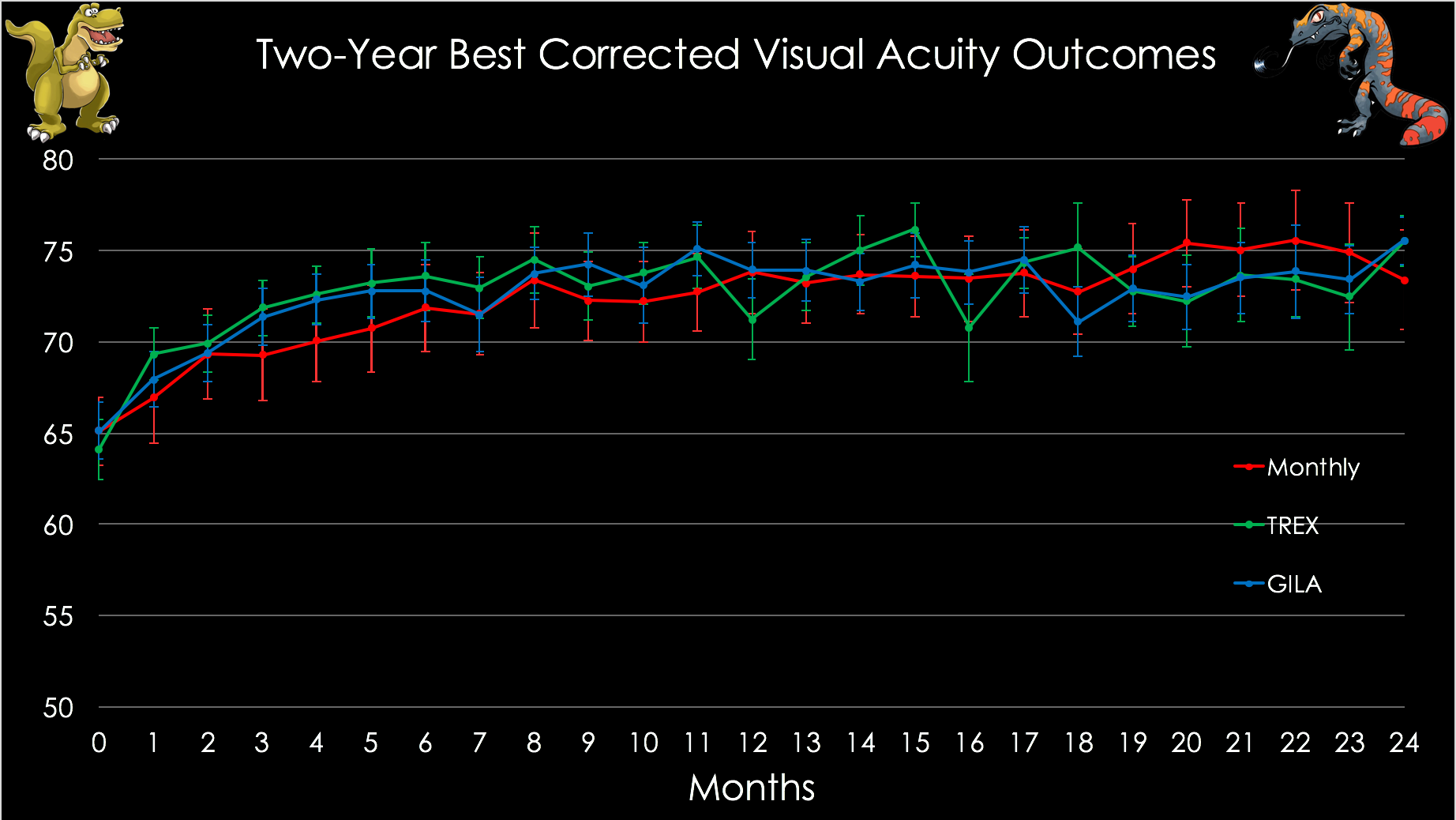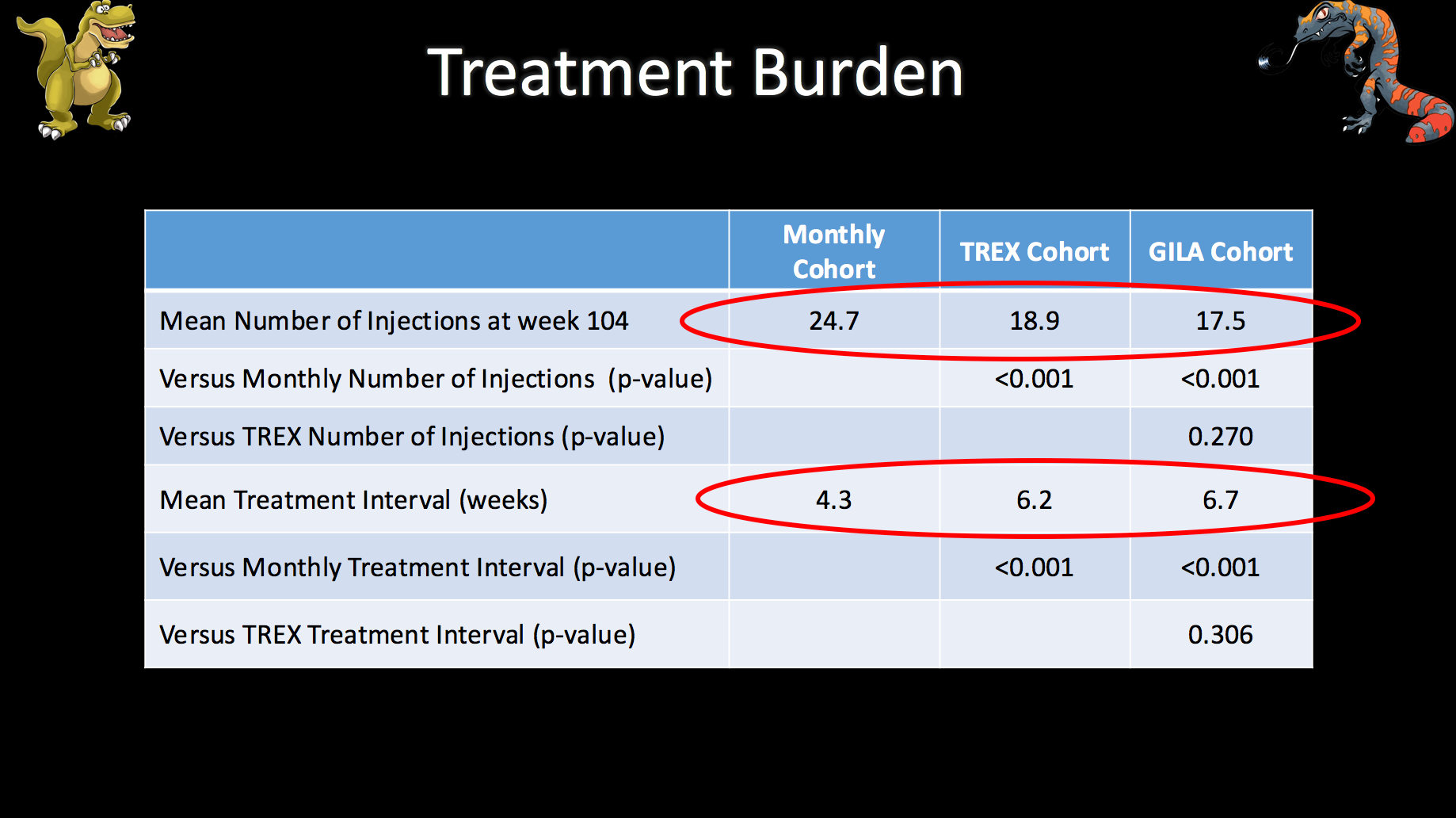Treat-and-extend protocol reduces burden of anti-VEGF treatment for DME
Results of the prospective TREX-DME study provide an evidence base for using a treat-and-extend protocol for administering anti-VEGF injections for eyes with diabetic macular edema.
By Cheryl Guttman Krader;Reviewed by David M. Brown, MD
Results from two years of follow-up in a prospective, randomized clinical trial support the use of a treat-and-extend (TAE) regimen for managing diabetic macular edema (DME).
The investigator-initiated study, known as TREX-DME, found that anatomic and functional benefits were similar among patients receiving TAE ranibizumab (Lucentis, Genentech) with or without guided focal laser compared with controls getting anti-VEGF injections on a fixed monthly schedule.
The treatment burden, however, was reduced significantly with the TAE approach, although adjuvant treatment with focal laser did not provide any statistically significant benefit for improving outcomes or reducing injection burden compared with TAE ranibizumab alone, said David M. Brown, MD.
“The RISE and RIDE studies with ranibizumab were the first DME studies to demonstrate robust vision gains and maintenance of the benefits with monthly anti-VEGF therapy compared to standard of care with focal laser,” explained Dr. Brown. “When applying the findings to clinical practice, however, two important questions remained. First, can the same outcomes be achieved with less-frequent therapy, such as with a TAE protocol that is often used in the clinic, and is there benefit from adding laser to the anti-VEGF therapy?”
Dr. Brown is in private practice and clinical research coordinator, Greater Houston Retina Research, Retina Consultants of Houston, TX.
“The TREX-DME trial was designed to answer those questions,” Dr. Brown outlined. “The overall results show that DME can be safely and effectively managed with a treat-and-extend regimen with or without adjunct guided laser. While on average at 2 years, adjunct laser did not provide additional benefit, ongoing 3-year results and subgroup analyses are being performed to determine which patients might benefit from guided laser closure of micro-aneurysms.”
TREX-DME study outlined
TREX-DME randomized 150 eyes 1:2:2 to receive ranibizumab 0.3 mg given monthly, by a TAE protocol (TREX group), or by TAE with guided laser photocoagulation (GILA group). The guided laser treatment uses a non-contact laser with eye tracking (Navilas, OD-OS).
Spot placement is guided by fluorescein angiography and delivered to all micro-aneurysms found on fluorescein angiography. Laser photocoagulation was performed at week 2 and then every 3 months in the GILA group.
“The Navilas laser can treat and close each micror-aneurysm with amazing precision and accuracy based on its eye-tracked fluorescein guidance,” Dr. Brown said.
Both the TREX and GILA groups initially received 4 monthly doses of ranibizumab. Beginning at week 12, the dosing interval was extended by 2-week increments as long as central foveal thickness measured by spectral-domain OCT was ≤325 µm.
Groups similar in BCVA
The three groups were similar in their baseline best corrected visual acuity (BCVA, 20/50 Snellen equivalent) and central subfield retinal thickness (CRT, 430 µm to 480 µm. Eighty percent of eyes completed follow-up to 2 years (See Figure 1).

Figure 1: Both treat-and-extend cohorts (with and without adjunct guided laser) demonstrate improved and sustained visual acuity similar to the monthly ranibizumab cohort. (Image courtesy of David Brown, MD)
At 2 years, mean change from baseline CRT in the monthly, TREX, and GILA cohorts was -146 µm, -142 µm, and -175 µm, respectively. All groups achieved a robust improvement in BCVA early on that was maintained over the 2-year duration.
At the end of 2 years, mean improvement from baseline was numerically greater in the TREX and GILA cohorts, compared with eyes receiving monthly ranibizumab, 11.4 letters and 10.5 letters versus 8.3 letters, but there were no statistically significant differences between groups.
The proportion of eyes with a ≥3-line gain in BCVA was also similar in the monthly ranibizumab, TREX, and GILA groups, 24%, 27%, and 30%, respectively, and no eyes lost ≥3 lines of BCVA.
Mean injections
Mean number of injections received over the 2-year period was 24.7 in the ranibizumab monthly cohort, 18.9 for the TREX eyes, and 17.5 for the GILA group. Mean treatment interval was about 4.3 weeks for eyes randomized to monthly ranibizumab, 6.2 weeks for TREX, and 6.7 weeks in the GILA group (See Figure 2).

Figure 2: Both treat-and-extend cohorts (with and without adjunct guided laser) demonstrate statistically significant reduction in treatment burden over the monthly ranibizumab cohort. (Image courtesy of David M. Brown, MD)
The differences in favor of using a TAE approach compared with the monthly regimen were strongly statistically significant (P <0.001). There were no statistically significant differences in the mean number of monthly injections or mean treatment interval comparing the TREX and GILA groups, perhaps due to small sample size, said Dr. Brown.
A total of 117 guided laser treatments were administered in year 2. The average number of laser treatments received per patient in the GILA group was 3.1 during the first year and 1.9 during year 2.
Safety was good in all groups. The only ocular serious adverse event was a case of vitreous hemorrhage in the TAE cohort. Six patients died during the study, but none of the deaths were study-related.
David M. Brown, MD
This article is based on a presentation given by Dr. Brown at the Retina Subspecialty Day, held prior to the 2017 American Academy of Ophthalmology meeting. Dr. Brown is a consultant to and receives grant support from Genentech/Roche, Regeneron/Bayer, Novartis and other companies. Genentech partially funded TREX-DME study and OD-OS funded the lasers.
Newsletter
Keep your retina practice on the forefront—subscribe for expert analysis and emerging trends in retinal disease management.